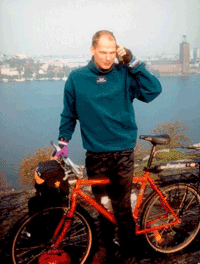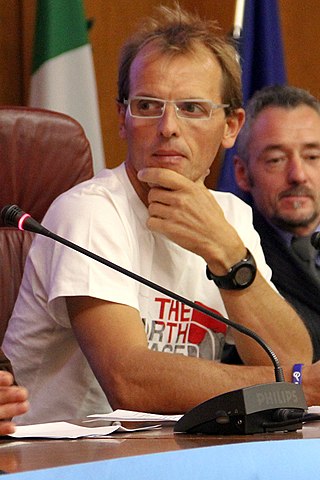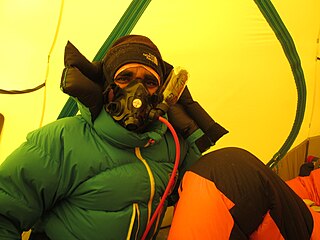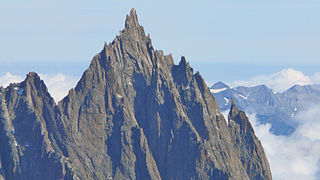
Reinhold Andreas Messner is an Italian climber, explorer, and author from South Tyrol. He made the first solo ascent of Mount Everest and, along with Peter Habeler, the first ascent of Everest without supplemental oxygen. He was the first person to climb all 14 eight-thousanders, doing so without supplementary oxygen. Messner was the first to cross Antarctica and Greenland with neither snowmobiles nor dog sleds and also crossed the Gobi Desert alone. He is widely considered to be the greatest mountaineer of all time.

Cho Oyu is the sixth-highest mountain in the world at 8,188 metres (26,864 ft) above sea level. Cho Oyu means "Turquoise Goddess" in Tibetan. The mountain is the westernmost major peak of the Khumbu sub-section of the Mahalangur Himalaya 20 km west of Mount Everest. The mountain stands on the China Tibet–Nepal Koshi Pradesh border.

The eight-thousanders are the 14 mountains recognised by the International Mountaineering and Climbing Federation (UIAA) as being more than 8,000 metres (26,247 ft) in height above sea level, and sufficiently independent of neighbouring peaks. There is no precise definition of the criteria used to assess independence, and at times, the UIAA has considered whether the list should be expanded to 20 mountain peaks by including the major satellite peaks of eight-thousanders. All of the eight-thousanders are located in the Himalayan and Karakoram mountain ranges in Asia, and their summits lie in an altitude known as the death zone.

Dhaulagiri, located in Nepal, is the seventh highest mountain in the world at 8,167 metres (26,795 ft) above sea level, and the highest mountain within the borders of a single country. It was first climbed on 13 May 1960 by a Swiss-Austrian-Nepali expedition. Annapurna I is 34 km (21 mi) east of Dhaulagiri. The Kali Gandaki River flows between the two in the Kaligandaki Gorge, said to be the world's deepest. The town of Pokhara is south of the Annapurnas, an important regional center and the gateway for climbers and trekkers visiting both ranges as well as a tourist destination in its own right.

Lars Olof Göran Kropp was a Swedish adventurer and mountaineer, the first Scandinavian to climb Mount Everest without oxygen. He made a solo ascent of Mount Everest without bottled oxygen or Sherpa support on 23 May 1996, after traveling there from Sweden by bicycle and foot.

Alan Hinkes OBE is an English Himalayan high-altitude mountaineer from Northallerton in North Yorkshire. He is the first British mountaineer to claim all 14 Himalayan eight-thousanders, which he did on 30 May 2005.

Jean-Christophe Lafaille was a French climber noted for a number of difficult ascents in the Alps and Himalaya, and for what has been described as "perhaps the finest self-rescue ever performed in the Himalaya", when he was forced to descend the mile-high south face of Annapurna alone with a broken arm, after his climbing partner had been killed in a fall. He climbed eleven of the fourteen eight-thousanders, many of them alone or by previously unclimbed routes, but disappeared during a solo attempt to make the first winter ascent of Makalu, the world's fifth highest mountain.

Baintha Brakk or The Ogre is a steep, craggy mountain, 7,285 metres (23,901 ft) high, in the Panmah Muztagh, a subrange of the Karakoram mountain range. It is located in Gilgit-Baltistan, Pakistan. It is famous for being one of the hardest peaks in the world to climb: twenty-four years elapsed between the first ascent in 1977 and the second in 2001.

Illimani is the highest mountain in the Cordillera Real of western Bolivia. It lies near the cities of El Alto and La Paz at the eastern edge of the Altiplano. It is the second highest peak in Bolivia, after Nevado Sajama, and the eighteenth highest peak in South America. The snow line lies at about 4,570 metres (15,000 ft) above sea level, and glaciers are found on the northern face at 4,983 m (16,350 ft). The mountain has four main peaks; the highest is the south summit, Nevado Illimani, which is a popular ascent for mountain climbers.

Ali Nasuh Mahruki is a professional mountain climber, writer, photographer and documentary film producer. He climbed to the summit of Mount Everest and was the first ever Turkish person to climb the Seven Summits.
Wojciech Kurtyka is a Polish mountaineer and rock climber, one of the pioneers of the alpine style of climbing the biggest walls in the Greater Ranges. He lived in Wrocław up to 1974 when he moved to Kraków. He graduated as engineer in electronics. In 1985 he climbed the "Shining Wall," the west face of Gasherbrum IV, which Climbing magazine declared to be the greatest achievement of mountaineering in the twentieth century. In 2016, he received the Piolet d'Or for lifetime achievement in mountaineering.

Simone Moro is an Italian mountaineer known for having made first winter ascents of four of the fourteen eight-thousanders: Shishapangma in 2005, Makalu in 2009, Gasherbrum II in 2011, and Nanga Parbat in 2016. No other climber has made more first winter ascents of an eight-thousander in history. He has summited Everest four times, in 2000, 2002, 2006, and 2010.
Andrew James Lock OAM is an Australian mountaineer. He became the first, and still remains the only, Australian to climb all 14 "eight-thousanders" on 2 October 2009, and is the 18th person to ever complete this feat. He climbed 13 of the 14 without bottled oxygen, only using it on Mount Everest, which he has summited three times. He retired from eight-thousander climbing in 2012.

Kinga Baranowska is a Polish mountaineer. She made ascents of nine eight-thousanders and is the first Polish woman to have climbed Dhaulagiri, Manaslu and Kangchenjunga. She has also climbed the seven summits.
Iván Vallejo is a high-altitude mountaineer from Ecuador. On 1 May 2008, he became the 14th person to reach the summit of all 14 mountains above 8,000 meters, and the 7th without use of supplemental oxygen. He is the first, and still the only, Southern Hemisphere climber to complete all 14 eight-thousanders, without supplemental oxygen.
Carlos Carsolio Larrea is a Mexican mountain climber. Carsolio is known for being the fourth man and the second youngest to climb the world's 14 eight-thousander mountains, all of them without supplementary oxygen.

Expedition climbing, is a type of mountaineering that uses a series of well-stocked camps on the mountain that lead to the summit, and which are supplied by teams of mountain porters. In addition, expedition climbing can also employ multiple 'climbing teams' to work on the climbing route—not all of whom are expected to make the summit—and allows the use of supports such as fixed ropes, aluminum ladders, supplementary oxygen, and sherpa climbers. By its nature, expedition climbing often requires weeks to complete a given climbing route, and months of pre-planning given the greater scale of people and equipment that need to be coordinated for the climb.

The Aiguille du Grépon, informally known as The Grepon, is a mountain in the Mont Blanc Massif in Haute-Savoie, France. The Grepon has a Southern and Northern peak, which are the highest points of a sharp granite ridge to the east of the Glacier des Nantillons above Chamonix and northeast of the Aiguille du Midi. A madonna statue is situated on the Southern peak.

Alpine climbing is a type of mountaineering that involves using any of a broad range of advanced climbing skills, including rock climbing, ice climbing, and/or mixed climbing, to summit typically large routes in an alpine environment. While alpine climbing began in the European Alps, it is used to refer to climbing in any remote mountainous area, including in the Himalayas and in Patagonia. The derived term alpine style refers to the fashion of alpine climbing to be in small lightly-equipped teams who carry their own equipment, and do all of the climbing.















